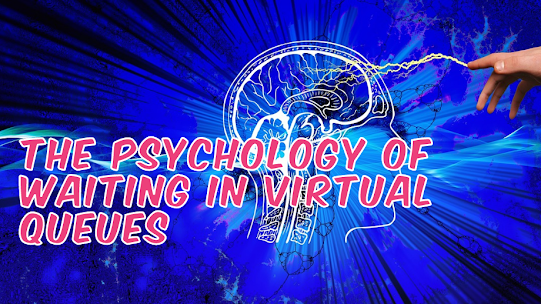The advent
of the internet has revolutionized our lives in many ways, and one of the most
significant changes has been the ability to queue up for things online. In
recent years, online waiting has become a ubiquitous feature of our daily
lives, as we wait in virtual queues for customer service, popular products, and
even for virtual events. Waiting in virtual queues has become an unavoidable
part of modern life, and it can have a significant psychological impact on
individuals.
In this
article, we will explore the psychology of waiting in virtual queues, including
the emotions and behaviors that can arise from this experience. We will also
provide some tips and strategies to help you make the wait more bearable.
The
Psychology of Waiting in Virtual Queues:
The
experience of waiting in virtual queues can be frustrating and stressful for
many individuals. When we wait in a physical line, we can see the people in
front of us and the progress being made toward our goal. However, in virtual
queues, we have no visual cues to indicate how long we will have to wait, which
can lead to feelings of uncertainty and anxiety.
Furthermore,
the lack of human interaction can make the experience of waiting in virtual
queues feel isolating and lonely. We are often left to our own thoughts and
emotions, which can be a recipe for negative thinking and spiraling anxiety.
Research has
shown that waiting in virtual queues can trigger a range of emotions, including
frustration, anger, and anxiety. These emotions can have a significant impact
on our mental health and well-being, as well as our overall satisfaction with
the experience.
One of the
key reasons why waiting in virtual queues can be so challenging is that it goes
against our natural instinct for instant gratification. We are used to getting
what we want immediately, thanks to the convenience of the internet and
on-demand services. Waiting in virtual queues can feel like an unwelcome
intrusion on this expectation, and can be especially frustrating when we have
no control over the wait time.
However,
waiting in virtual queues can also have some positive effects on our
psychology. For example, it can help to build resilience and patience, two
valuable qualities that are essential in many areas of life. It can also give
us a sense of accomplishment when we finally reach our goal after a long wait.
Tips for
Making the Wait More Bearable:
If you find
yourself stuck in a virtual queue, there are several strategies you can use to
make the wait more bearable. Here are some tips to help you manage the
experience:
Keep
Yourself Busy:
One of the
best ways to make the wait more bearable is to keep yourself busy. Use the time
to catch up on work, read a book, or listen to music. The more you can distract
yourself, the less you will focus on the wait time.
Practice
Mindfulness:
Mindfulness
is the practice of being present and fully engaged at the moment. It can help
to reduce feelings of anxiety and frustration and can make the wait more
bearable. Try to focus on your breathing, or use a guided meditation app to
help you stay calm and centered.
Connect with
Others:
Although
waiting in virtual queues can be a lonely experience, it doesn't have to be.
Connect with others who are in the same situation as you, whether it's through
social media or online forums. Sharing your experience with others can help you
feel less isolated and more supported.
Set
Realistic Expectations:
It's
important to set realistic expectations for how long the wait will be. Don't
assume that the wait will be over quickly, as this can lead to frustration and
disappointment. Instead, try to accept that the wait may take longer than you
anticipated, and prepare yourself mentally for this possibility.
Take Breaks:
If you find
yourself becoming overwhelmed or anxious, take a break from the queue







0 Comments